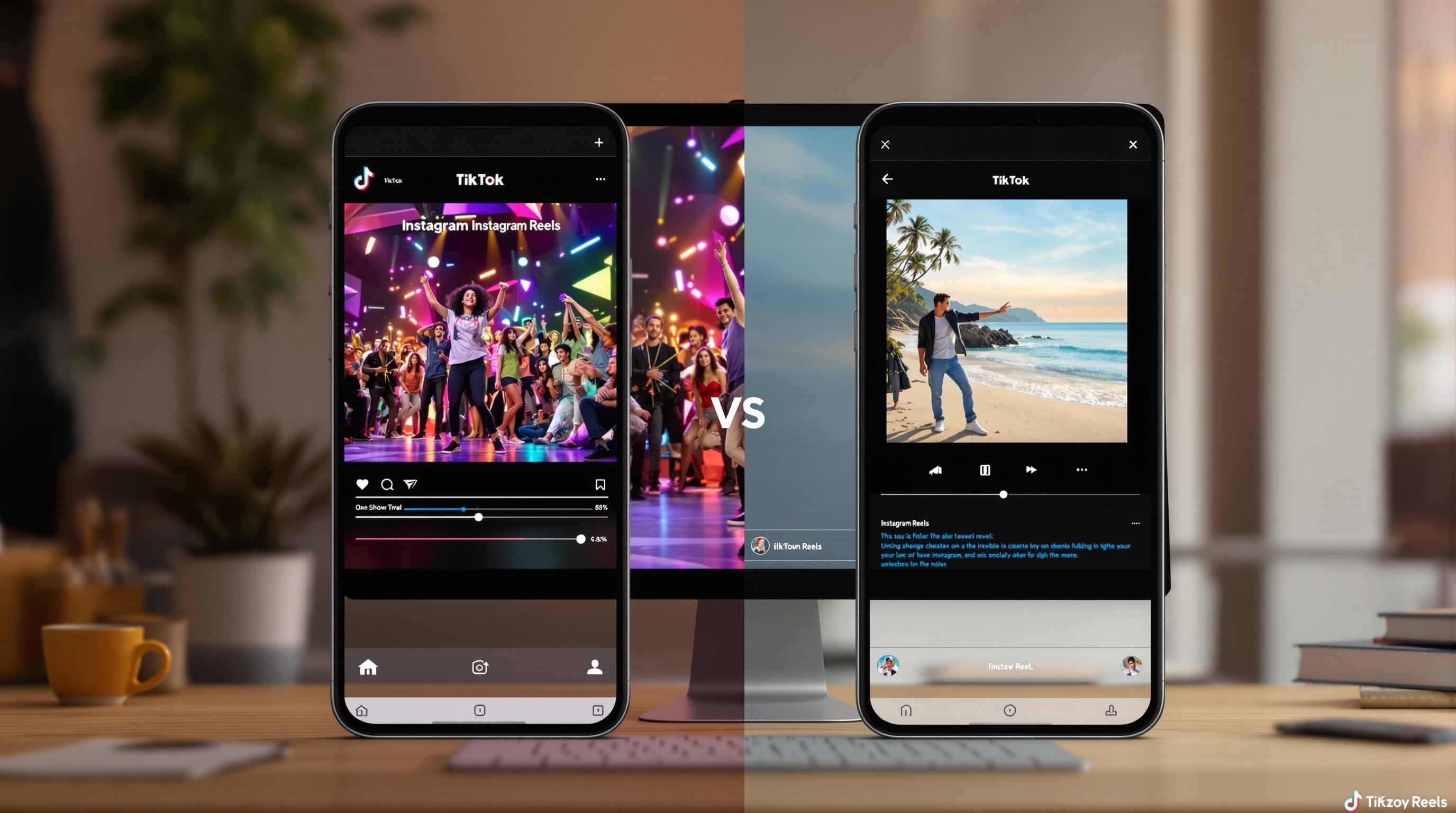
Social media is evolving fast, and 2025 is shaping up to be a year of big shifts. Here are the top 5 trends every marketer should know:
- AI-Powered Content Creation: By 2025, 75% of marketers will use AI tools, boosting efficiency in creating posts, videos, and visuals. AI-generated content is driving higher engagement across platforms.
- Short-Form Videos Dominate: Platforms like TikTok, Instagram Reels, and YouTube Shorts continue to thrive, with vertical, bite-sized videos leading to higher completion rates and purchases.
- Social Shopping Grows: In-app shopping features on Instagram, TikTok, and Pinterest make it easier than ever for users to buy directly from social media. Social commerce is projected to hit $2.9 trillion by 2026.
- Privacy is Key: Stricter data privacy laws like the EU AI Act and U.S. NYCDPA mean brands must prioritize transparency and security to build trust.
- New Platforms Rising: Emerging platforms like Bluesky and Kick offer fresh opportunities for marketers to connect with niche audiences.
Quick Overview
| Trend | What to Know |
|---|---|
| AI Content Creation | 75% of marketers use AI tools; boosts engagement with visuals and captions. |
| Short Videos | TikTok leads with 5.53% engagement; vertical videos perform 90% better. |
| Social Shopping | In-app checkouts and live shopping events drive immediate sales. |
| Data Privacy | 80% of the global population is now covered by privacy laws; transparency builds trust. |
| Emerging Platforms | Platforms like Bluesky and Kick offer new ways to engage specific audiences. |
These trends highlight the importance of combining technology, creativity, and trust to stay ahead in social media marketing.
The future of social media: 2025 trends you need to know
1. AI Tools for Content Creation
By 2025, 75% of marketers are expected to use AI tools for social media, with 19% relying on them for content generation . These numbers highlight the growing role of AI in reshaping how content is created.
AI-driven content isn't just efficient - it performs better. For example, LinkedIn posts featuring AI-generated images see 98% more comments, while tweets with enhanced visuals can triple engagement .
"AI serves as a dynamic extension of creative teams, significantly boosting efficiency", says Gabby Beckford, Founder of SeekPTO and creator behind @packslight .
Popular AI Tools and Their Features
Here’s a breakdown of some top AI tools by category:
| Category | Tool | Features | Starting Price |
|---|---|---|---|
| Social Copy | Copy.ai | Captions, social media copywriting | $49/month |
| Visual Content | Canva Pro | 600k+ templates, Magic Design, AI Text-to-Image | $12.99/month |
| Video Creation | InVideo | Script-to-video, AI voiceovers | $30/month |
| Content Analysis | Mentionlytics | Brand monitoring, sentiment analysis | Custom pricing |
| Meme Creation | Supermeme.ai | 1,000+ templates, multi-language support | Free tier available |
Getting the Most Out of AI Tools
Here are some practical ways to use AI tools effectively:
- Use AI tools like Buffer's AI Assistant to plan content by analyzing trends and generating ideas .
- Create attention-grabbing visuals with AI generators. For instance, meme content drives 60% more organic engagement compared to standard posts .
- Monitor performance with AI-powered analytics. Currently, 16% of organizations rely on AI for sentiment analysis .
"AI is a force multiplier for creative expression", says David Raichman, Creative Director at Ogilvy .
While AI enhances creativity and efficiency, human oversight is key to maintaining a brand's authentic voice . This combination allows businesses to use AI effectively while staying prepared for evolving trends in social media marketing.
2. Growth of Short Videos
Short-form videos are taking over social media. Meta reports that 60% of time spent on Facebook and Instagram is dedicated to video content . The numbers across platforms highlight just how big this shift is.
Platform Performance and Engagement
| Platform | Engagement Rate | Avg. Daily Usage |
|---|---|---|
| TikTok | 5.53% | 45.8 minutes |
| Instagram Reels | 4.36% | 17.6 million hours |
| YouTube Shorts | 3.80% | Varies |
TikTok leads the pack with 2.051 billion global users and is expected to hit 1.8 billion monthly active users by the end of 2025 .
What Makes Video Content Work?
Certain factors play a huge role in how well videos perform:
- Vertical videos are king, with 90% higher completion rates compared to horizontal ones . This format is perfect for mobile viewers.
- Videos drive action: 89% of viewers admit they’re influenced to make a purchase after watching a video, which explains why 91% of businesses now use video in their marketing strategies .
These trends are shaping how brands attract and retain followers as social platforms continue to evolve.
Tips for Creating Short Videos That Work
- Grab attention fast: 71% of viewers decide within seconds if a video is worth their time .
- Tailor content per platform: TikTok thrives on raw, authentic clips, while Instagram Reels favor polished, curated visuals .
- Use captions: Many people watch videos on mute, so captions are a must - but don’t skimp on engaging audio for those who do listen.
Trends to Watch
- Authenticity over perfection: TikTok encourages a raw, unfiltered approach .
- User-Generated Content (UGC): UGC is 35% more memorable than traditional ads and drives 29% higher conversions .
- AI tools: Creating professional-looking videos is becoming easier thanks to AI advancements .
"People crave authenticity, and UGC delivers that in a bite-sized format. This is shown in recent trends like de-influencing: the rise here due to how audiences resonate with genuine, relatable content over polished, brand-centric messaging." – Ashlee Fitzgerald, Production Director, Superside
These trends reflect the ongoing push for fresh approaches in digital content creation. Short videos are not just a passing trend - they’re reshaping how brands connect with their audiences.
sbb-itb-3858882
3. Direct Shopping Features
Direct shopping features are transforming how people shop on social platforms, making the journey from discovery to purchase smoother than ever. With global social commerce sales expected to reach $2.9 trillion by 2026 , these tools are becoming essential for businesses. Short videos drive engagement, and now these features close the loop by turning views into purchases.
Platform Shopping Features
| Platform | Key Features | Notable Stats |
|---|---|---|
| Product stickers, Checkout | 83% of users discover products | |
| TikTok | Shoppable posts, Live shopping | #TikTokMadeMeBuyIt: 50B+ views |
| Product Pins, Shop tab | 85% of weekly users make purchases | |
| Personalized storefronts, Messenger shopping | Offers tailored product recommendations |
Success Stories in Social Shopping
Tommy Hilfiger took social shopping to the next level by hosting a live runway show on Roblox. During the event, users could instantly buy digital versions of the collection for their avatars . This fusion of physical and digital shopping highlights how brands are reimagining commerce.
Features Driving Sales
- In-App Checkouts: With stored payment details and one-tap purchases, these features minimize cart abandonment.
- Live Shopping Events: Gymshark's TikTok live shopping events, paired with campaigns like #Gymshark66, created buzz and drove instant sales .
- AI Recommendations: Advanced algorithms suggest products tailored to individual preferences, simplifying the buying process .
Making Social Shopping Work
- Visual Appeal: Sephora uses tutorials, reviews, and influencer partnerships in shoppable posts to attract buyers.
- Interactive Tools: L'Oréal’s Snapchat AR tools let users virtually try on makeup, helping them feel confident about their purchase .
- Building Trust: With 91% of shoppers relying on reviews , brands highlight testimonials and user-generated content to reassure potential buyers.
These strategies show how social commerce is evolving to turn engagement into immediate sales.
4. Data Privacy in Marketing
As direct shopping features rely more on detailed data insights, strong privacy measures have become a top priority. Data privacy now plays a key role in social media marketing, with nearly 80% of the global population covered by privacy laws .
New Privacy Regulations in 2025
Upcoming regional regulations are introducing stricter standards:
| Region | Regulation | Key Requirements |
|---|---|---|
| United States | NYCDPA (June 2025) | Focuses on protecting minors' data |
| European Union | EU AI Act | Sets rules for AI training data |
| United Kingdom | Data Use and Access Bill | Updates GDPR framework |
| Southeast Asia | Indonesia PDP Law | Strengthens enforcement |
Building Trust Through Transparency
Being open about data practices fosters customer loyalty. Research shows that 94% of consumers are more likely to stick with brands that prioritize protecting their data . Apple's App Tracking Transparency policy highlights this trend, with over 90% of iOS users opting out of third-party tracking .
Privacy-First Marketing Strategies
Focusing on privacy in marketing can set brands apart by building trust and credibility. This approach aligns with the growing demand for personalized yet secure digital interactions.
"Essentially, the CCPA, CPRA, and the other data privacy acts that are popping up around the US are establishing legal enforcement mechanisms around personal control of one's personal data and codifying many of the core principles of our industry - namely, transparency, notice, and the right to opt out. Only now, instead of the industry self-regulating these matters, state governments are intervening to take control of that enforcement."
Security Best Practices
- Use two-factor authentication, limit data access to authorized personnel, and adopt consent management platforms to handle compliance efficiently .
- Regularly conduct privacy audits and update policies as needed .
Simplified data collection procedures not only help meet compliance requirements but also enhance customer trust.
Data Minimization Approach
"Increasing data complexity heightens threats to privacy compliance and security. Companies need expert management of data and privacy operations, strong security policies and protocols, ongoing staff education, and robust tools to protect themselves and their customers." – Adelina Peltea, CMO of Usercentrics
Collecting only necessary data helps businesses stay compliant while maintaining a competitive edge in today's privacy-focused landscape.
5. New Platform Options
The social media world keeps changing, and new platforms are shaking things up for marketers. To stay ahead in 2025, keep an eye on these emerging platforms - they offer fresh ways to connect with your audience, much like AI and short video trends.
Rising Stars in Social Media
Several platforms are gaining momentum, each with distinct features that can help marketers reach specific audiences:
| Platform | Active Users | Key Features | Best For |
|---|---|---|---|
| Bluesky | 25M+ | Decentralized, Twitter-like | Text-based engagement |
| Kick | 50M | Live streaming | Gaming, creative content |
| RedNote | Growing | E-commerce integration | Lifestyle, shopping |
| Lemon8 | Growing | Visual content | Brand collaborations |
| Gowalla | Growing | Location-based | Local marketing |
Platform-Specific Opportunities
Bluesky, introduced in February 2023, focuses on decentralized communication, offering a space free from heavy censorship. Kick, on the other hand, caters to gaming and creative communities, creating a unique marketing environment with its streamer-friendly policies.
Niche Platform Benefits
Smaller, specialized platforms are also carving out space for marketers. Networks like The Student Room, with 10 million monthly users, and Bēhance, home to 24 million creative professionals, provide opportunities for highly targeted engagement. These platforms are perfect for connecting with specific communities in meaningful ways.
Strategic Considerations
Social media users expect brands to stay relevant. Statistics show that 90% of consumers turn to social platforms for trends, 93% expect brands to engage with online culture, and 73% will switch to competitors if a brand fails to respond on social media . These numbers highlight the importance of staying active and responsive.
Data-Driven Decision Making
"In 2025 and beyond, you'll need to cross your t's and dot your i's when it comes to emerging social media platforms, trends, and technology – it's easy to get caught out." - Epidemic Sound
When evaluating new platforms, consider these factors:
- Platform Maturity: Allow time for newer platforms to establish their user base.
- Audience Alignment: Ensure the platform’s demographics match your target audience.
- Content Format: Check if your content strategy fits the platform’s strengths.
- Engagement Metrics: Track performance indicators to measure success.
Focus on platforms that align with your brand, and adapt your approach to fit each platform’s unique culture.
Conclusion
As we look ahead to 2025, staying competitive in social media marketing means blending cutting-edge technology with genuine audience engagement. With social commerce expected to reach $1.2 trillion, businesses will need to rethink their strategies to keep up with this rapid growth. The trends shaping this landscape point to clear steps brands should take to thrive.
Key Actions for Success
To stay ahead, brands should focus on these key areas:
Content Creation and Distribution
- Create engaging video content to drive product discovery and audience interaction.
- Use AI tools thoughtfully while maintaining a consistent and genuine brand voice.
- Ensure social content is optimized for search to improve visibility.
Community and Commerce
- Build strong, interactive communities through regular engagement.
- Add shopping features directly into social platforms for seamless transactions.
- Tap into user-generated content, which makes up 55.7% of TikTok's content .
"They're a TikTok generation with 6-second attention spans but will research 13 pieces of content before reaching out to a sales rep." - Irina Novoselsky, CEO of Hootsuite
Measuring Impact
Tracking the right metrics is essential for understanding success. Here are some key areas to monitor:
| Metric | Focus | Purpose |
|---|---|---|
| Engagement | Shares, Comments | Gauge content appeal |
| Commerce | Direct Sales | Measure ROI |
| Community | Member Growth | Build brand loyalty |
| Privacy | Data Protection | Maintain user trust |
The future of social media marketing calls for content that delivers real value while respecting privacy. Brands that combine innovative tools with meaningful audience connections will be well-positioned to succeed by following the strategies outlined here.




































![Top 7 Best Instagram Growth Services in 2025 [RESULTS]](/cdn-cgi/image/fit=contain,format=auto,width=null/https://cdn.prod.website-files.com/67840d1d88a886f29a66a4c1/6795d12917ee4501b9eddf73_6795c731964f791db3b566c4-1737870861582.jpg)


![UpGrow Review – The Best Instagram Growth Service in 2025 [TESTED]](/cdn-cgi/image/fit=contain,format=auto,width=null/https://cdn.prod.website-files.com/67840d1d88a886f29a66a4c1/6795040db42e404207732526_6794fd9c964f791db3b48de9-1737818779111.jpg)


